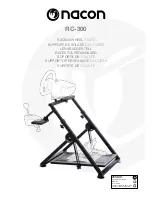
--16--
Pilot Lamps:
"Battery Full"
(Board battery fully charged,
green
):
If it is on:
Battery has been charged to 100 %, trickle charge U2, finished.
If it is flashing:
Main charging process is effected in the charging phase U1, indication of the charging state of
75 % (lead), approx. 90 % (LiFePO4) (short flashing), gradual increase to 100 % (long flashing).
Off:
Main charging process is still being executed in the phase I.
"Main Charge"
(Main charging board battery,
yellow
):
If it is on:
Main charging process is effected in the charging phase I or U1
.
Off:
Trickle charge U2.
If it is flashing:
1. Battery temperature sensor is not connected with charging program LiFePO4!
2. External overvoltage board battery > 15.50 V after 20 seconds,
automatic reset after drop to the normal nominal voltage.
"Current"
(Charging Current,
red
):
The lighting intensity will be
reduced or increased depending on the supplied charging
current
.
"Board OUT"
(Board battery,
yellow
)
:
If it is on:
The board battery will be controlled and charged during operation.
If it turns off shortly
every 2 s:
Only LiFePO4: Battery temperature below 0 °C. The charging current can be reduced for
battery protection for all modes of charging. If the battery is discharged, longer charging times.
If it is flashing:
Battery Protection: Battery overtemperature > 50 °C (depending on type), switchover to low
safety charging voltage and half of the max. charging current. Automatic return, as soon as the
temperature is 2 °C less.
"Start IN"
(Starter Battery,
yellow
)
:
If it is on:
Pilot lamp for the starter battery during operation.
If it is flashing:
The voltage of the starter battery is too low or too high (only with D+ control).
Is flashing shortly
every 2 sec.:
During idle mode and external charging of the board battery (such as mains supply charger,
solar) auxiliary charging for the starter battery is active to keep its starting capacity (only with
switch position "B", see page 14).
"Power"
(Mains,
red)
:
If it is on:
The charging converter had been activated and is ready for operation.
If it turns off shortly
every 2 s:
The power control of the charging converter has reduced the output capacity by more than 30
% (starter battery discharge protection, starting capacity is maintained), since the voltage of the
starter battery dropped below the adjusted value for "Reduction of the charging capacity"
(table 4).
The charging capacity will be increased automatically, as soon as the voltage exceeds the value
"increase of the charging capacity".
If it is flashing:
1. Disconnection by safety timer. Duration of the charging phase I was too long (15 hours)
due to too many consumers or defective battery (short circuit of the cells).
Reset only by removal of the signal at "D+ / Kl.15" (engine, ignition off).
2. Internal unit failure (overheating), automatic reset after cooling down.
Off:
Charging converter in idle mode.
All LEDs
"Battery Full", "Main Charge", "Current", "Board OUT", "Start IN" and "Power"
are flashing simultaneously:
The positions of the upper 4 selector switches (charging program acid, gel, AGM, LiFePO4) are incorrect. For
reasons of safety, the unit has switched-off.
Set the desired charging program battery type "Board" (design, technology), from page 11.





































